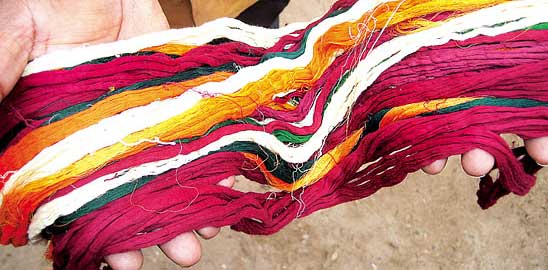All India Report of Sixth Economic Census
The Sixth EC proposes to provide up to date information on number of establishments and number of persons employed therein, activity wise, of all the sectors (excluding crop production, plantation, public
The Sixth EC proposes to provide up to date information on number of establishments and number of persons employed therein, activity wise, of all the sectors (excluding crop production, plantation, public

Pankaj Sekhsaria finds out why handloom is viable
Khadi has strayed from its objective of providing a livelihood to artisans in rural areas. For preserving the ethos of khadi, rather than just tinker with the existing system a restructuring of the Khadi and Village Industries Commission is necessary. The potential of khadi needs to be exploited for its inherent worth rather than be supported for charity.
An oligopolistic market, fluctuating market conditions, inadequate modernisation and the subordinate status of hired workers have contributed to the poor living conditions of workers in Sircilla, a powerloom centre of Andhra Pradesh. The state and central governments need to intervene in a more organised fashion to end the distress.
Driven by situational factors in the Malenad region, intellectuals at the Kavi-Kavya Trust in 1996, formed a new initiative called the "Charaka Gramodyog Unit", primarily to generate alternate reliable employment opportunities for rural women.
Everyone gets inspiration from mother. But here is a story of a young innovator who not only got inspired by his mother but also relieved the pain and suffering of all the mothers of his community. The financial condition of his society has improved a lot due to his innovation, the automatic Asu machine. It has revived the dying silk sari of Pochampalli variety. Innovation rewriting the history.
Based on fieldwork, this paper examines the problems and prospects of the handloom sector in Andhra Pradesh. One major finding is that the growth performance of cooperatives determines the growth of other institutions
Computer aided units drive Chirala farmers out of business Utter penury greets you in every house that has a loom. Twenty-three-year-old Sivasarada and his family, including his parents and ageing grandmother, put in an average of 10 hours of work a day to prepare 12 pieces of 8 m-long Pattamarapu for a Tamil Nadu-based export company. Still they earn just Rs 4,000 a month. In Jandrapeta village, weaver couple Sulochana and Rama Rao get Rs 2,400 for 36m of kurta tops. School dropout rates among the children in the community are high because of poverty and the need for additional labour.
Computer aided units drive Chirala farmers out of business The loom in Aruna Kumari's badly lit, mud-walled house in Epurupalem village runs from 5 a.m. to 11 p.m., with either Aruna or her husband working at it constantly. Her ageing grandmother contributes by winding spools of yarn and joining threads of the weft for 10 hours daily. Together, the family produces 13 Chirala sarees with ornate, heavy-work pallu and border in a month, for a combined income of a little over Rs 4,000.

The loom in Aruna Kumari's badly lit, mud-walled house in Epurupalem village runs from 5 a.m. to 11 p.m., with either Aruna or her husband working at it constantly. Her ageing grandmother contributes

At a time when they should be going to school, weavers' children are helping their parents to make ends meet. Since able-bodied adults are mostly busy with loom work, and elderly people are unable to perform fine work due to failing eye sight, children are roped in for making new wefts by joining threads to a piece from the old weave.